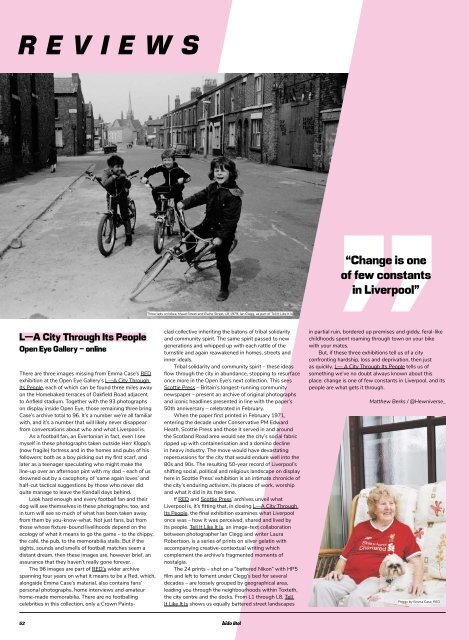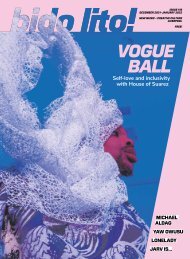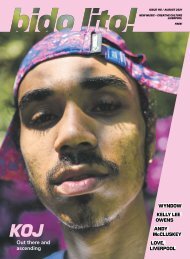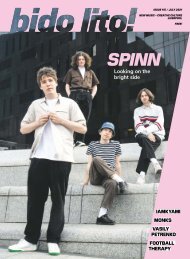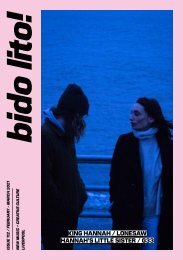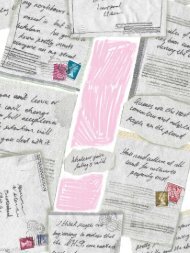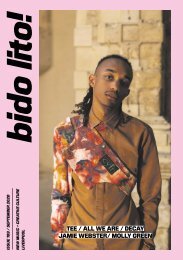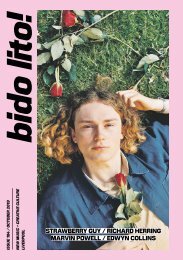Issue 113 / April-May 2021
April-May 2021 issue of Bido Lito! magazine. Featuring: PIXEY, AYSTAR, SARA WOLFF, DIALECT, AMBER JAY, JANE WEAVER, TATE COLLECTIVE, DEAD PIGEON GALLERY, DAVID ZINK YI, SAM BATLEY, FURRY HUG, FELIX MUFTI-WRIGHT, STEALING SHEEP and much more.
April-May 2021 issue of Bido Lito! magazine. Featuring: PIXEY, AYSTAR, SARA WOLFF, DIALECT, AMBER JAY, JANE WEAVER, TATE COLLECTIVE, DEAD PIGEON GALLERY, DAVID ZINK YI, SAM BATLEY, FURRY HUG, FELIX MUFTI-WRIGHT, STEALING SHEEP and much more.
You also want an ePaper? Increase the reach of your titles
YUMPU automatically turns print PDFs into web optimized ePapers that Google loves.
REVIEWS<br />
“Change is one<br />
of few constants<br />
in Liverpool”<br />
Three lads on bikes, Maud Street and Elaine Street, L8 1979, Ian Clegg, as part of Tell It Like It Is<br />
L—A City Through Its People<br />
Open Eye Gallery – online<br />
There are three images missing from Emma Case’s RED<br />
exhibition at the Open Eye Gallery’s L—A City Through<br />
Its People, each of which can be found three miles away<br />
on the Homebaked terraces of Oakfield Road adjacent<br />
to Anfield stadium. Together with the 93 photographs<br />
on display inside Open Eye, those remaining three bring<br />
Case’s archive total to 96. It’s a number we’re all familiar<br />
with, and it’s a number that will likely never disappear<br />
from conversations about who and what Liverpool is.<br />
As a football fan, an Evertonian in fact, even I see<br />
myself in these photographs taken outside Herr Klopp’s<br />
(now fragile) fortress and in the homes and pubs of his<br />
followers; both as a boy picking out my first scarf, and<br />
later as a teenager speculating who might make the<br />
line-up over an afternoon pint with my dad – each of us<br />
drowned out by a cacophony of ‘same again loves’ and<br />
half-cut tactical suggestions by those who never did<br />
quite manage to leave the Kendall days behind.<br />
Look hard enough and every football fan and their<br />
dog will see themselves in these photographs, too, and<br />
in turn will see so much of what has been taken away<br />
from them by you-know-what. Not just fans, but from<br />
those whose fixture-bound livelihoods depend on the<br />
ecology of what it means to go the game – to the chippy,<br />
the café, the pub, to the memorabilia stalls. But if the<br />
sights, sounds and smells of football matches seem a<br />
distant dream, then these images are, however brief, an<br />
assurance that they haven’t really gone forever.<br />
The 96 images are part of RED’s wider archive<br />
spanning four years on what it means to be a Red, which,<br />
alongside Emma Case’s material, also contains fans’<br />
personal photographs, home interviews and amateur<br />
home-made memorabilia. There are no footballing<br />
celebrities in this collection, only a Crown Paintsclad<br />
collective inheriting the batons of tribal solidarity<br />
and community spirit. The same spirit passed to new<br />
generations and whipped up with each rattle of the<br />
turnstile and again reawakened in homes, streets and<br />
inner ideals.<br />
Tribal solidarity and community spirit – these ideas<br />
flow through the city in abundance, stopping to resurface<br />
once more in the Open Eye’s next collection. This sees<br />
Scottie Press – Britain’s longest-running community<br />
newspaper – present an archive of original photographs<br />
and iconic headlines presented in line with the paper’s<br />
50th anniversary – celebrated in February.<br />
When the paper first printed in February 1971,<br />
entering the decade under Conservative PM Edward<br />
Heath, Scottie Press and those it served in and around<br />
the Scotland Road area would see the city’s social fabric<br />
ripped up with containerisation and a domino decline<br />
in heavy industry. The move would have devastating<br />
repercussions for the city that would endure well into the<br />
80s and 90s. The resulting 50-year record of Liverpool’s<br />
shifting social, political and religious landscape on display<br />
here in Scottie Press’ exhibition is an intimate chronicle of<br />
the city’s enduring activism, its places of work, worship<br />
and what it did in its free time.<br />
If RED and Scottie Press’ archives unveil what<br />
Liverpool is, it’s fitting that, in closing L—A City Through<br />
Its People, the final exhibition examines what Liverpool<br />
once was – how it was perceived, shared and lived by<br />
its people. Tell It Like It Is, an image-text collaboration<br />
between photographer Ian Clegg and writer Laura<br />
Robertson, is a series of prints on silver gelatin with<br />
accompanying creative-contextual writing which<br />
complement the archive’s fragmented moments of<br />
nostalgia.<br />
The 24 prints – shot on a “battered Nikon” with HP5<br />
film and left to foment under Clegg’s bed for several<br />
decades – are loosely grouped by geographical area,<br />
leading you through the neighbourhoods within Toxteth,<br />
the city centre and the docks. From L1 through L8, Tell<br />
It Like It Is shows us equally battered street landscapes<br />
in partial ruin, bordered up premises and giddy, feral-like<br />
childhoods spent roaming through town on your bike<br />
with your mates.<br />
But, if these three exhibitions tell us of a city<br />
confronting hardship, loss and deprivation, then just<br />
as quickly, L— A City Through Its People tells us of<br />
something we’ve no doubt always known about this<br />
place: change is one of few constants in Liverpool, and its<br />
people are what gets it through.<br />
Matthew Berks / @Hewniverse_<br />
Peggy by Emma Case, RED<br />
52


